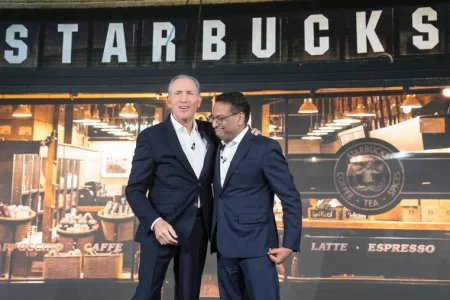Starbucks has made headlines by firing Laxman Narasimhan as CEO after less than a year. Narasimhan, who started as CEO in March 2023, has been replaced by Brian Niccol, the current CEO of Chipotle Mexican Grill. This sudden leadership change is notable as Starbucks is grappling with declining sales and pressure from activist investors.
Who is Laxman Narasimhan?
Laxman Narasimhan, born in India, has an impressive career of nearly 30 years. He worked at McKinsey & Company, PepsiCo, and Reckitt. At Reckitt, he was known for guiding the company during the COVID-19 pandemic. Narasimhan is also noted for his strong stance on work-life balance. He believed in leaving work by 6 p.m., a practice that some found inspiring but which might have conflicted with the demanding nature of leading a global company like Starbucks.

Why Did Starbucks Fire Narasimhan?
The reasons for Narasimhan’s departure are not fully clear. However, several factors likely contributed. Under his leadership, Starbucks faced significant challenges. The company reported two consecutive quarters of declining sales, and a poor earnings report in April 2024 worsened the situation. Starbucks’ stock price fell by 20% before Narasimhan’s exit was announced.
Additionally, Narasimhan faced pressure from activist investors like Elliott Investment Management. These investors were unhappy with the company’s performance and pushed for leadership changes to boost the share price. The timing of Narasimhan’s exit also coincides with ongoing negotiations with unionized stores. Narasimhan had been seen as more supportive of unions compared to his predecessor, Howard Schultz.
Laxman Narasimhan’s tenure as CEO of Starbucks highlighted several challenges. One key issue was his perceived lack of alignment with the fast-paced demands of leading a global brand. His strong emphasis on work-life balance, while valuable, may have conflicted with the intense pressure and long hours often required for such a high-profile role. Additionally, his approach to addressing declining sales and market issues might not have been as aggressive or innovative as needed. This gap in leadership style and strategic response could have contributed to the company’s decision to seek a new direction with Brian Niccol.
Other Contributing Factors
Narasimhan’s departure is part of a broader trend in the business world. In 2024, 74 out of 191 CEOs of major U.S. companies have left their positions. Starbucks has also been dealing with controversy, including calls for boycotts related to its alleged ties to Israel. These controversies have added to the company’s struggles and might have influenced the decision to make a leadership change.
Who is the New Starbucks CEO?
Brian Niccol, the new CEO of Starbucks, is set to take over from Laxman Narasimhan. Niccol has been the CEO of Chipotle Mexican Grill since 2018. During his tenure at Chipotle, Niccol has been credited with leading a remarkable turnaround. Under his leadership, Chipotle’s revenue nearly doubled, and the company saw substantial growth in its stock value. His efforts to modernize the company’s operations, including enhancing digital ordering and delivery services, have been widely praised.
Niccol’s background includes a strong track record in driving innovation and operational efficiency. Before Chipotle, he served as the CEO of Taco Bell, where he was known for implementing successful marketing campaigns and expanding the brand’s menu. His leadership style is often described as dynamic and forward-thinking, which aligns with Starbucks’ need for a fresh approach to address its current challenges.
Starbucks’ board chair, Mellody Hobson, highlighted Niccol’s achievements, noting his ability to drive significant growth and value creation. Hobson believes Niccol’s experience and proven success in leading a major restaurant chain will be beneficial for Starbucks. Investors and industry experts are hopeful that Niccol’s leadership will help revitalize Starbucks, improve sales performance, and navigate the complex market conditions the company is facing.
Niccol will officially assume his new role on September 9. Until then, Rachel Ruggeri, Starbucks’ CFO, will serve as the interim CEO. The transition period will be closely watched as both investors and customers anticipate how Niccol will steer Starbucks through its current difficulties and beyond.

Conclusion
The sudden removal of Laxman Narasimhan as CEO highlights the difficulties Starbucks is facing. The company has struggled with declining sales and investor dissatisfaction. With Brian Niccol stepping in, Starbucks is hoping for a turnaround. Niccol’s proven track record is seen as a potential solution to the company’s current challenges. The coming months will be crucial for Starbucks as it navigates this leadership transition.





